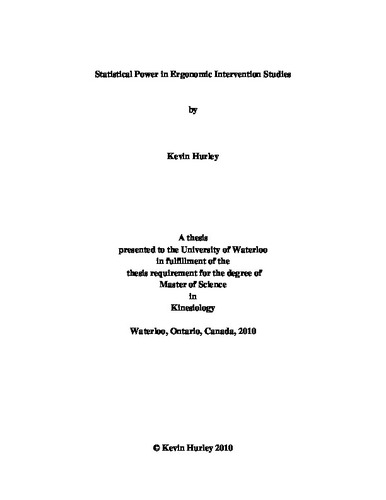| dc.description.abstract | As awareness of the costs of workplace injury and illness continues to grow, there has been an increased demand for effective ergonomic interventions to reduce the prevalence of musculoskeletal disorders (MSDs). The goal of ergonomic interventions is to reduce exposures (mechanical and psychosocial); however there is conflicting evidence about the impact of these interventions as many studies produce inconclusive or conflicting results. In order to provide a clearer picture of the effectiveness of these interventions, we must find out if methodological issues, particularly statistical power, are limiting this research. The purpose of this study was to review and examine factors influencing statistical power in ergonomic intervention papers from five peer reviewed journals in 2008. A standardized review was performed by two reviewers. Twenty eight ergonomic intervention papers met the inclusion criteria and were fully reviewed. Data and trends from the reviewed papers were summarized specifically looking at the research designs used, the outcome measures used, if statistical power was mentioned, if a rationale for sample size was reported, if standardized and un-standardized effect sizes were reported, if confidence intervals were reported, the alpha levels used, if pair-wise correlation values were provided, if mean values and standard deviations were provided for all measures and the location of the studies. Also, the studies were rated based on the outcomes of their intervention into one of three categories (shown to be effective, inconclusive and not shown to be effective). Between these three groupings comparisons of post hoc power, standardized effect sizes, un-standardized effect sizes and coefficients of variation were made. The results indicate that in general, a lack of statistical power is indeed a concern and may be due to the sample sizes used, effect sizes produced, extremely high variability in some of the measures, the lack of attention paid to statistical power during research design and the lack of appropriate statistical reporting guidelines in journals where ergonomic intervention research may be published. A total of 69.6% of studies reviewed had a majority of measures with less than .50 power and 71.4% of all measures used had CVs of > .20. | en |

